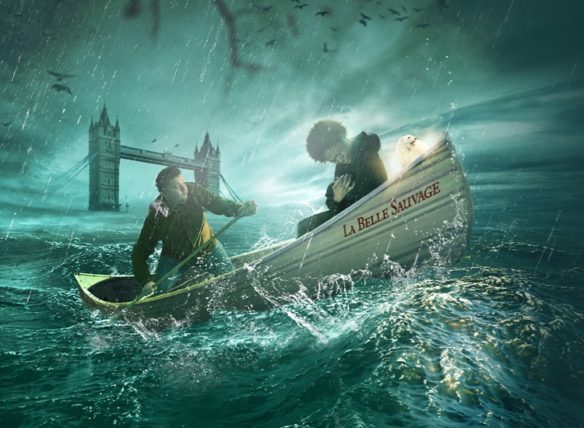
By Martin Morse Wooster: When I read in the Financial Times about how Britain’s National Theatre was adapting Sir Philip Pullman’s La Belle Sauvage, the first volume of his Book of Dust trilogy, I told myself, “That’s a play for me! I’ll just fly over to London and see it! OGH is made of money, and he’ll happily pay my expenses!”
Fortunately, I didn’t have to go to London, because the theatre came to me, with a screening of the National Theatre Live production playing at the American Film Institute. So, I spent a pleasant Saturday afternoon seeing it.
The show began with about 15 minutes of filler. I’m a sucker for listening to theatre people talk about what they do, but the show began with a lot of gas from technical people about how difficult the production was and how special they felt doing it. Bryony Lavery, who wrote the adaptation, explained how hard it was to turn a 300-page book into a 2 1/2-hour play, and would Pullman’s millions of fans be pleased with it?
Well, the rule of thumb is that a hundred pages of fiction equals one hour of film, which is why 200-page novels get turned into two-hour movies. So, turning a 300-page novel into a play was not much more work.
As for Pullman’s “millions of fans.” He doesn’t have them in America, because the screening I went to had about a dozen people, including four enthusiastic high schoolers[1] and was screened by the American Film Institute in their small theatre, not their large one. (By contrast, the mid-week mid-afternoon screening I went to of Memoria, a weirdo sf film that amply succeeds in its perverse goal of being the most boring film ever made, had 25 people and was subsequently extended for two weeks.)
One other feature I didn’t like is that the production had a laugh track, with loud guffaws piped in whenever the production wanted to tell us something was funny. I’ve been to some pretty goofy plays, but I’ve never heard anyone in an audience laugh as loud as I did watching The Book of Dust.
What’s the plot? This is set a dozen years before the His Dark Materials trilogy. Remember that Pullman doesn’t like religion and doesn’t like authority, so his villains in his world, a parallel universe with slightly less technology than ours, is the Magisterium, a religious authority that resembles the Catholic Church. Lyra is born and is quickly discovered to have powers the bad guys want. The Church nearly captures her several times, but hairbreadth escapes occur and its authority repeatedly questioned until the happy conclusion.
Rather than elaborate on the plot, let me focus on three points which made it interesting theater.
In Pullman’s world, all the characters have “demons” or spirit animals. In the play, these animals are portrayed by puppets, who are articulated and look like origami. A few of the smaller ones can be manipulated by an actor, but the larger ones have puppeteers manipulating the puppets and supplying voices. There’s one large puppet, a hyena who laughs at inappropriate times, who is on wheels and pushed. The puppets worked for me, but I don’t know enough about puppetry to describe what’s right about them.
Pullman’s universe is one where the Thames has flooded and much of the novel is set in torrential rain. All the rain and floodwaters are CGI, with flooding being portrayed on video. In many scenes there are about as many props as there would be in an effects-laden movie, except that the flood is more stylized and less realistic than in a movie. I thought the effect worked very well.
One other semi-special effect is how Lyra is portrayed. About half the time the baby is played by…a baby! Director Nicholas Hytner said in an intermission that they had five babies take turns playing Lyra, and the ones I saw did their duty and smiled and cooed without having issues. However, about half the time a puppet was used; I learned if you see Lyra’s head it’s a baby and if you don’t it’s a puppet.
Finally, I liked that in Pullman’s universe Latin is a language with power and if you cast a spell with Latin it works. This gave actors a chance to show off their classical educations.
Did I like it? Yes, I’m glad I saw it. But I have two reservations.
First, it was theatre on film, which meant everything I saw was mediated through a screen, making it more like a Zoom meeting than a con where you can chat with your friends in the con suite. I once saw Kathleen Turner play Joan Didion on stage where she delivered an entire 100-minute play by herself without a net. Turner’s tightrope act would be far less thrilling if I saw it on TV.
Is the Guinness better in Ireland? Yes—because you’re in Ireland! Similarly, seeing plays in London would be much more interesting than in a theatre 15 minutes away from home.
The second problem is that at least on stage La Belle Sauvage is a thrill-on-every-page plot. Lyra is nearly captured—but she escapes! Then she’s nearly captured—and escapes again! But we know she will win, because this book is a prequel. There wasn’t much room for character development or for actors to act.
Still, seeing La Belle Sauvage in a movie theatre was better than not seeing it at all. By the end of the production the dozen attendees shared Pullman tips and I was told the full-cast audio production of His Dark Materials was well worth my time.
So, it was a good afternoon in the theatre—and much cheaper than going to London.
Meanwhile, here is three minutes of what I saw: “’It’s a baby!’ from The Book of Dust – La Belle Sauvage”.
[1] Who I am sure went to BCC or Whitman.
